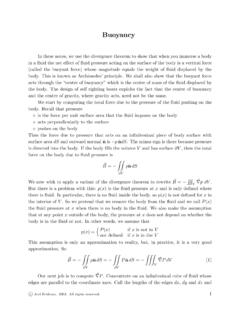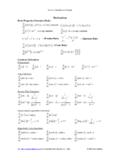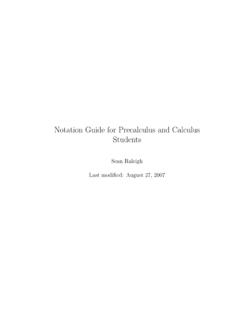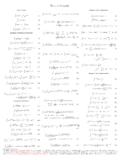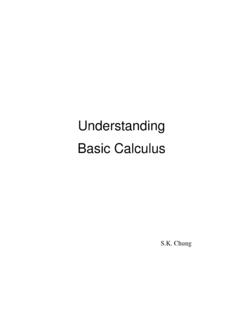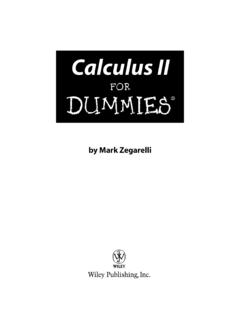Transcription of The Fundamental Theorem of Calculus
1 The Fundamental Theorem of CalculusThe single most important tool used to evaluate integrals is called The Fundamental Theo-rem of Calculus . It converts any table of derivatives into a table ofintegrals and vice it isLetf(x) be a function which is defined and continuous fora x 1:Define, fora x b,F(x) = xaf(t)dt. ThenF(x) is differentiable andF (x) =f(x)Part 2:LetG(x) be any function which is defined and continuous on [a, b] andwhich is also differentiable and obeysG (x) =f(x) for alla < x < b. Then baf(x)dx=G(b) G(a)or baG (x)dx=G(b) G(a) Theorem 1( Fundamental Theorem of Calculus ).A functionG(x) that obeysG (x) =f(x) is called an antiderivative off.
2 The form baG (x)dx=G(b) G(a) of the Fundamental Theorem is occasionally called the netchange Theorem . Proof of Part definitionF (x) = limh 0F(x+h) F(x)hFor notational simplicity, let s only consider the case thatfis alway nonnegative. ThenF(x+h) = the area of the region{(t, y) a t x+h,0 y f(t)}F(x) = the area of the region{(t, y) a t x,0 y f(t)}SoF(x+h) F(x) = the area of the region{(t, y) x t x+h,0 y f(t)}That s the more darkly shaded region in the figurexax+hy=f(t)tc Joel Feldman. 2015. All rights 29, 2015 Astruns fromxtox=h,f(t) runs only over a very range of values, all close tof(x).So the darkly shaded region is almost a rectangle of widthhand heightf(x) and so hasan area which is very close tof(x)h.
3 ThusF(x+h) F(x)his very close tof(x). In the limith 0,F(x+h) F(x)hbecomes exactlyf(x), which is exactly what we want. We won t justifythis limiting argument on a mathematically rigorous level (which is why weput quotationmarks around Proof , above), but it should at least look very reasonable to you. Proof of Part want to show that baf(t)dt=G(b) G(a), or equivalently that baf(t)dt G(b) +G(a) = 0. We ll just renamebtoxand show thatH(x) = xaf(t)dt G(x) +G(a)is always zero. This will imply, in particular, thatH(b) = baf(t)dt G(b) +G(a) is we ll check ifH(x) is at least a constant, by computing the derivativeH (x) =ddx xaf(t)dt G (x)=f(x) f(x)(by Part 1 and the hypothesisG (x) =f(x))= 0 SoH(x) must be a constant function and the value of the constant isH(a) = aaf(t)dt G(a) +G(a) = 0as we ll first do some examples illustrating the use of part 1 of the Fundamental Theoremof Calculus .
4 Then we ll move on to part 2 (ddx x0e t2dt)Findddx x0e don t know how to evaluate the integral x0e t2dt. In fact x0e t2dtcannotbe expressed in terms of standard functions like polynomials, exponentials, trig functions andso on. Even so, we can find its derivative by just applying the first part of the FundamentalTheorem of Calculus withf(t) =e t2anda= 0. That givesddx x0e t2dt=e x2 Example 2c Joel Feldman. 2015. All rights 29, 2015 Example 3 (ddx x20e t2dt)Findddx x20e again, we will apply part 1 of the Fundamental Theorem of Calculus . Butwe must do so with some care. The Fundamental Theorem tells us howto compute thederivative of functions of the form xaf(t)dt.
5 The integral x20e t2dtisnotof the specifiedform because the upper limit of x20e t2dtisx2while the upper limit of xaf(t)dtisx. Thetrick for getting around this obstacle is to define the auxiliary functionE(x) = x0e t2dtThe Fundamental Theorem tells us thatE (x) =e x2. (We found that in Example 2, above.)The integral of interest is x20e t2dt=E(x2)So by the chain ruleddx x20e t2dt=ddxE(x2) = 2x E (x2) = 2xe x4 Example 3 Example 4 (ddx x2xe t2dt)Findddx x2xe again, we can t just blindly apply the Fundamental Theorem . Thistime, notonly is the upper limit of integrationx2rather thanx, but the lower limit of integration alsodepends onx, unlike the lower limit of the integral xaf(t)dtof the Fundamental we can use the basic properties of integrals to split x2xe t2dtinto pieces whosederivatives we already know.
6 X2xe t2dt= 0xe t2dt+ x20e t2dt= x0e t2dt+ x20e t2dtSo, by the previous two examples,ddx x2xe t2dt= ddx x0e t2dt+ddx x20e t2dt= e x2+ 2xe x4 Example 4c Joel Feldman. 2015. All rights 29, 2015We re almost ready for examples using part 2 of the Fundamental Theorem . We just needa little terminology and notation.(a) A functionF(x) whose derivativeF (x) =f(x) is called an antiderivative off(x).(b) The symbol f(x)dxis read the indefinite integral off(x) . It stands forallfunctions having derivativef(x). IfF(x) is any antiderivative off(x), andCis any constant, then the derivative ofF(x)+Cis againf(x), so thatF(x)+Cis also an antiderivative off(x).
7 Conversely, the difference between any twoantiderivatives off(x) must be a constant, because a function has derivativezero if and only if it is a constant. So f(x)dx=F(x) +C, with the consantCcalled an arbitrary constant or constant of integration .(c) The symbol f(x)dx bameans take any function whose derivative isf(x). Call the function you havechosenF(x). Then f(x)dx bameansF(b) F(a).Definition ll later develop some strategies for computing more complicated integrals. But fornow, we ll stick to integrals that are simple enough that we can just guess the 6 Find 21x main step in evaluating an integral like this is finding the indefinite integralofx.
8 That is, finding a function whose derivative isx. So we have to think back and try andremember a function whose derivative is something likex. We recall thatddxxn=nxn 1We want the derivative to bexto the power one, so we should taken= 2. So far, we haveddxx2= 2xThis derivative is just a factor of 2 larger than we want. So we divide the whole equation by2. We now haveddx(12x2)=xwhich says that12x2is an antiderivative forx. Once one has an antiderivative, it is easy tocompute the definite integral 21x dx=a function withderivativex. 12x2 21=1222 1212=32c Joel Feldman. 2015. All rights 29, 2015as well as the indefinite integral x dx=12x2+CExample 6 Example 7 Find /20sinx again, the crux of the solution is guessing a function whose derivative issinx.
9 The standard derivative that comes closest to sinxisddxcosx= sinxwhich is the derivative we want, multiplied by a factor of 1. So we multiply the wholeequation by ( cosx)= sinxThis tells us that the indefinite integral sinxdx= cosx+C. To answer the question,we don t need the whole indefinite integral. We just need one functionwhose derivative issinx, that is, one antiderivative of sinx. We ll use the simplest one, namely cosx. Theprescribed integral is /20sinx dx=a function withderivative sinx. cosx /20= cos 2+ cos 0 = 0 + 1 = 1 Example 7 Example 8 Find again, the crux of the solution is guessing a function whose derivative standard way to get derivatives that are powers ofxisddxxn=nxn 1 That is not going to work this time, since to get1xon the right hand side we need to taken= 0, which gives a right hand side of 0.
10 Fortunately, we also haveddxlnx=1xwhich is exactly the derivative we want. We re now ready to compute the prescribed integral. 211xdx=a function withderivative1/x. lnx 21= ln 2 ln 1 = ln 2c Joel Feldman. 2015. All rights 29, 2015 Example 8 Example 9 Find 1 we saw in the last example,ddxlnx=1xBut we cannot use lnxin this example because, here,xruns from 2 to 1, and in particularis negative, and lnxis not defined whenxis negative. A variant of lnxwhich is definedwhenxis negative is ln( x) = ln|x|, so let s computeddxln( x) =1 x( 1) =1xby the chain rule. Fortunately, this is exactly the derivative we want, so we re now ready tocompute the prescribed integral.






